Asian Art Association of the
Denver Art Museum tours Sorcar residence |
The Sorcar Residence, designed
by Manick Sorcar: (left) Front entry, (right) Rear view from the
lake side |
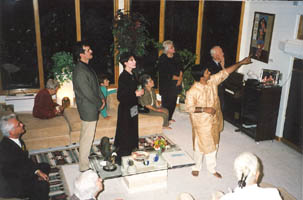
Sorcar talks describes some of his paintings |
September 25, 2001: Manick Sorcar's residence hits
the limelight. "Eastern Star", the
fascinating Rocky Mountain News article (August 18, 2001) about
the unique Sorcar Residence brought a surge of complements and good
wishes from friends and strangers from around the nation, but none
was so gratifying to the Sorcars as the visit of the Asian Art Association
of the Denver Art Museum, when its patron members had a first-hand
experience of its unique architecture and interior art work - all
done by Manick Sorcar. The tour was
an honor to the Sorcars.
|
The two dozen or so patron members headed by Elizabeth
Shwayder, the president of AAA, arrived at the residence at about
6:30 pm, when they were greeted by Manick, wife Shikha, and daughters
Piya and Payal. Following the traditional Indian ways, they removed
their shoes at the door. The tour began at 7 pm after they saw the
beautiful sunset from the large arched windows of the Great Room
overlooking lake Hyatt and distant mountain, and lasted for two
hours to complete the 7,800 sq .ft. house including the basement
studio. It began with an introduction of a large sculpture of Lord
Ganesha at the front entry, carved out of the trunk of a mango tree
from India. "He is the Hindu God of wisdom and prosperity.
We seek his blessings as we go in and out of the home, or start
a new venture", said Manick, "so we start our
tour with his blessings".
|
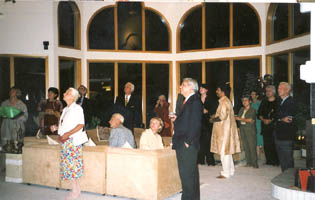
Asian Art Association Touring Sorcar Home |
Manick explains his
newspaper collage pieces |
|
The group expressed their admiration
for the unique architecture of the house with trios of large windows
arched at the top, and arched relief work on the stucco exterior.
"A series of arches inside an arch is a very Indian architecture",
explained Manick, "its roots go back to as early as the Gupta
period of Indian history. But its use maximized in the Mughal era
of 16th and 17th century when they used it in almost every structure
they built. Usually in the Indian architecture, there is a crest
at the center arch, but I had to avoid that as I didn't want it
to be too Indian. A compromise was necessary - after all someday
we have to sell the house". |
| Manick acted as the personal guide taking the distinguished
group room to room on a tour, answering questions, explaining each
of his art work on multi-media ranging
from traditional water paint on paper, acrylic on raw-silk, straw-paper
and bamboo trays, tile paintings, newspaper collages, oil-based
markers on newsprints, miniature painting with Indian ink to insulation
caulking artwork on a wall covered with floor tiles. |
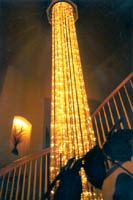
Two-story long chandelier
designed by Manick goes through round staircase |
|
The living room was an introductory art
gallery for the rest of the house which included a Mother and Child
(water paint), a Bengali style folk art of women on straw-paper
and bamboo trays, portraits of Mahatma Gandhi made with onion seeds,
and a unique portrait of Mother Teresa in a collage with relevant
newspapers pieces from Calcutta. "It is a part of Indian history",
explained Manick, "each line you see in this portrait is a
piece of newspaper from Calcutta that talks about Mother Teresa
and her great soul. It is a portrait of her made with her stories".
In the 22 ft high octagonal Great Room, visitors were introduced
to some of his other type of work. "Fascinating! How did
you do that?" exclaimed one member staring at the 8 ft
x 10 ft sculpture of the Street Musicians located 12 ft. above floor,
on the wall. "It looks like it is made of marble - how
did you get it up there?" "It is actually carved out of
a stack of industrial grade styrofoam sheets glued together",
explained Manick to everyone's surprise, "I like to experiment
with new media all the time. It took me about a month to complete".
|
 |
 |
The
group admires the newspaper collage of President Clinton and
Mrs. Clinton in Manick's basement studio |
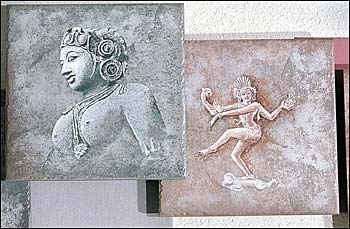 Tile Paintings by Manick Sorcar
Tile Paintings by Manick Sorcar |
The tile paintings on the east wall were equally fascinating to
the visitors. "Each of these art pieces relate to a very
special part of Indian history", explained Manick, "these
are based on the incredible statues of the 'Sun-Temple of Love'
at Konark, India, of the 13th century".
In the dining room the group was introduced to Manick's original
art work from his award-winning animation
Deepa & Rupa: A Fairy Tale From India.
They looked like water paint, but actually they were "paintings
on newsprints with oil-based markers", said Manick, "It
is a discovery I made by trial and error during the making of the
animation. These are some of the hundreds of background scenes from
my animation. I painted them on newsprints
with oil-based markers as I wanted to paint them fast, simultaneously
avoiding any kind of wrinkle that usually are associated with a
traditional water paint on paper. And it worked just great".
|
|
Sorcar's other rooms exhibited a series of variety of his art
work including a spice painting of Baby Ganesha, miniature portraits
on peanuts and even on a grain of rice.
Upstairs, the visitors were awestruck at the master bath which
itself was "a piece of art work", they said.
Looking through the columns of an Indian portico which separates
it from the bedroom, the bathroom perimeter walls are covered
with multi-layer mirrors of different shades, all cut as a mountain
at the top. An abundance of glass block walls tastefully located
around the bathroom reflect on the mirror to give an illusion
of reflecting water. The mirrors above represent the mountain
range. |
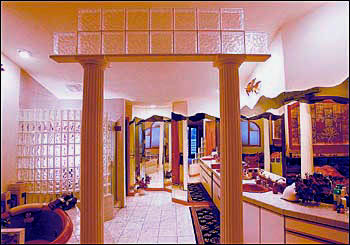 The interior of the Sorcar's master bath
The interior of the Sorcar's master bath |
The 20 ft long high-tech chandelier going thru the sweeping round
staircase was of great interest to the visitors. It is a cluster
of transparent plastic tubes housing a series of miniature lights
that inter-reflect and create an interesting effect. "It is
like going thru the space and looking at the glittering stars",
said Manick, "in its design I made sure I was not going to
change the bulbs every year. These bulb are designed to last for
40, 000 hours. So I don't have to touch them for at least 10 years,
and I like that".
Manick's collection of other arts included original art work of
Rajasthani painters and prints of artwork of Mughal period and Rajasthan
of 17th and 18th century, each enhanced with accent lights, and
an explanation card beneath it. |
Manick and Shikha with
Elizabeth Shwayder, president of AAA of the Denver Art Museum,
and
Ronald Y. Otsuka, the curator of Asian Arts |
|
The group visited Manick's computer studio
in the basement where he does his art work, and the blue-room psych
studio where live action shooting is mixed with animation. A large
newspaper collage covering the highlights of 1996 election with
portraits of smiling President Clinton and Mrs. Clinton brought
an awestruck smile in the group's faces. They realized it indeed
was a true piece of American history. It carried the story of the
entire election and the faces of Mr. and Mrs. Clinton were done
with actual newspaper pieces about them! The group admired the dozens
of awards received by Manick over the years from international film
festivals and other clubs and organizations for his animation films
and art work. |
| The tour ended with some
delicious Indian snacks prepared by Shikha, when the group relaxed
and gave rave reviews of what they had seen. "It is quite an
experience", "Incredible work!", "We are honored
to have met you", "when do you find time to do all these?"
- were the popular questions asked by most of the visitors. "Our
heartfelt gratitude for allowing us the privilege of visiting your
magnificent home", said Ms. Shwayder as they left and started
walking along the winding path in front of the home... and the Sorcars
were happy that they just had the most distinguished guests
for an incredible evening the memory of which is going to last for
a long long time. |
 |
| ( About Asian Art Association, reprinted from their published
brochure: "Founded in 1981, the AAA sponsors educational events
and social gatherings, including lectures, symposia, workshops,
and behind-the-scene tours of museums, galleries, and private collections.
AAA members meet Asian art specialists from around the world and
travel to see national and international touring exhibitions of
Asian art...The Asian Art Association plays a vital role in the
growth and development of the Asian art department where it enhances
the Denver Art Museum's efforts to collect, preserve and exhibit
Asian art. Through its cultural and educational activities, it promotes
an understanding of Asian art and culture among the entire community."
) |
|

